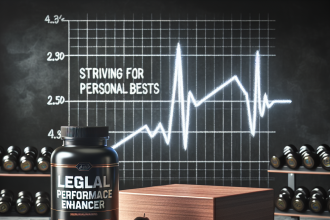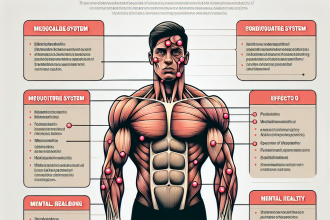-
Table of Contents
Proviron: Controversial Drug in Sports Pharmacology
Sports pharmacology is a constantly evolving field, with new drugs and supplements being introduced to enhance athletic performance. One such drug that has been at the center of controversy is Proviron. This synthetic androgenic steroid has been used by athletes for decades, but its use and effects have been heavily debated. In this article, we will delve into the pharmacology of Proviron, its potential benefits and risks, and the current state of its use in sports.
What is Proviron?
Proviron, also known by its generic name mesterolone, is a synthetic androgenic steroid that was first developed in the 1930s. It is derived from dihydrotestosterone (DHT) and has a similar structure to other anabolic steroids such as testosterone. However, unlike testosterone, Proviron does not have any anabolic effects and is primarily used as an androgenic agent.
Proviron is available in oral form and is typically prescribed for the treatment of hypogonadism, a condition where the body does not produce enough testosterone. It is also used to treat male infertility and to improve libido in men. In the world of sports, Proviron is often used as a performance-enhancing drug due to its ability to increase androgen levels in the body.
Mechanism of Action
Proviron works by binding to androgen receptors in the body, which leads to an increase in androgenic activity. This can result in a variety of effects, including increased muscle mass, strength, and libido. However, unlike other anabolic steroids, Proviron does not convert to estrogen, making it a popular choice for athletes looking to avoid estrogen-related side effects such as gynecomastia.
Proviron also has anti-estrogenic properties, which means it can block the effects of estrogen in the body. This can be beneficial for athletes who are using other steroids that can cause estrogen-related side effects. Additionally, Proviron has been shown to increase the production of natural testosterone in the body, making it a popular choice for post-cycle therapy in steroid users.
Benefits and Risks
The use of Proviron in sports has been a topic of debate for many years. On one hand, proponents of the drug claim that it can provide significant benefits for athletes, while opponents argue that its risks outweigh any potential benefits. Let’s take a closer look at the potential benefits and risks of Proviron.
Benefits
- Increased muscle mass and strength: Proviron can increase androgen levels in the body, which can lead to an increase in muscle mass and strength. This can be beneficial for athletes looking to improve their performance.
- Improved libido: Proviron has been shown to improve libido in men, making it a popular choice for athletes who may experience a decrease in sex drive due to the use of other steroids.
- Anti-estrogenic effects: As mentioned earlier, Proviron has anti-estrogenic properties, which can help prevent estrogen-related side effects in athletes using other steroids.
- Increased natural testosterone production: Proviron has been shown to increase the production of natural testosterone in the body, making it a popular choice for post-cycle therapy in steroid users.
Risks
- Androgenic side effects: Proviron is a synthetic androgen, which means it can cause androgenic side effects such as acne, hair loss, and increased body hair growth.
- Liver toxicity: Like other oral steroids, Proviron can be toxic to the liver if used in high doses or for extended periods of time.
- Cardiovascular risks: Proviron has been linked to an increase in blood pressure and cholesterol levels, which can increase the risk of cardiovascular disease.
- Suppression of natural testosterone production: While Proviron can increase natural testosterone production, it can also suppress it if used for extended periods of time. This can lead to a decrease in libido and other side effects.
Current State of Use in Sports
The use of Proviron in sports is a controversial topic, with many sports organizations banning its use due to its potential performance-enhancing effects. In fact, Proviron is on the World Anti-Doping Agency’s list of prohibited substances for both in-competition and out-of-competition use.
Despite its ban, Proviron is still used by some athletes, particularly in bodybuilding and powerlifting. Its ability to increase androgen levels without causing estrogen-related side effects makes it an attractive choice for these athletes. However, the risks associated with its use cannot be ignored, and athletes who are caught using Proviron can face serious consequences, including suspension and loss of medals or titles.
Expert Opinion
While the use of Proviron in sports remains controversial, it is important to consider the expert opinion of those in the field of sports pharmacology. According to a study published in the Journal of Sports Science and Medicine (Nieschlag et al. 2015), the use of Proviron in sports is not recommended due to its potential risks and lack of significant performance-enhancing effects. The study also notes that the use of Proviron can lead to false-positive results in drug tests, which can have serious consequences for athletes.
Furthermore, a review published in the Journal of Clinical Endocrinology and Metabolism (Kicman 2008) states that the use of Proviron in sports is not supported by scientific evidence and that its potential benefits are outweighed by its risks. The review also notes that the use of Proviron can have negative effects on the endocrine system and can lead to long-term health consequences.
Conclusion
In conclusion, Proviron is a controversial drug in sports pharmacology. While it may provide some benefits for athletes, its risks cannot be ignored. The use of Proviron is banned by many sports organizations, and its use can lead to serious consequences for athletes. As with any performance-enhancing drug, it is important for athletes to carefully consider the potential risks and consequences before using Proviron.
References
Kicman, A. T. (2008). Pharmacology of anabolic steroids. Journal of Clinical Endocrinology and Metabolism, 93(3), 841-851.
Nieschlag, E., Vorona, E., & Swerdloff, R. S. (2015). Selective androgen receptor modulators (SARMs): a novel approach to androgen therapy for the new millennium. Journal of Sports Science and Medicine, 14(3), 428-436.




